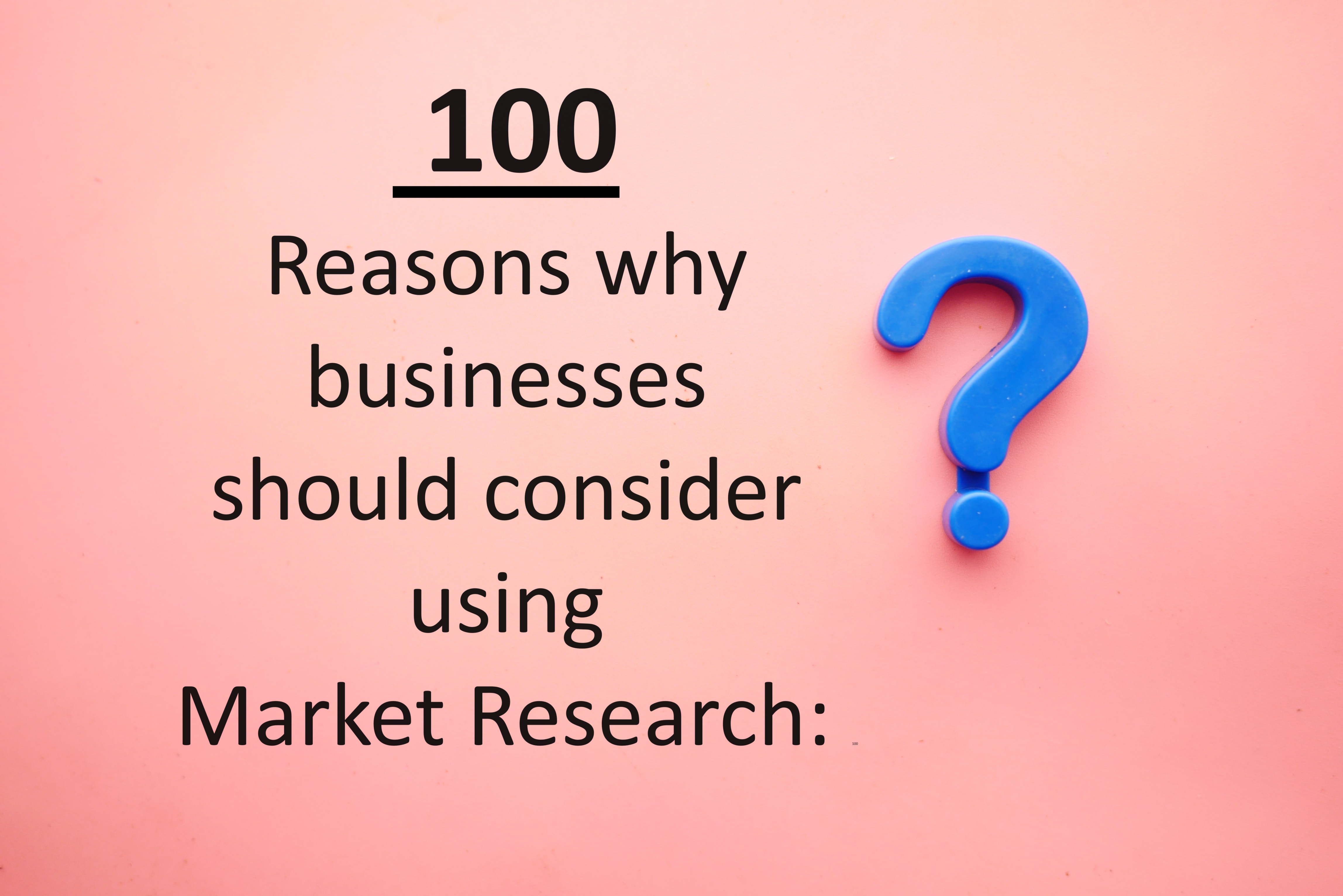Here are 100 reasons why businesses should consider using market research:
1
Identify new market opportunities.
2
Understand customer needs and preferences.
3
Analyze competitors for strategic advantage.
4
Mitigate potential risks in the market.
5
Optimize marketing strategies for better results.
6
Guide product development based on market demands.
7
Enhance product positioning in the market.
8
Determine optimal pricing strategies.
9
Identify and target specific market segments.
10
Forecast future sales trends.
11
Assess and improve brand perception.
12
Formulate effective market entry strategies.
13
Understand and predict consumer behavior.
14
Gain insights into global market trends.
15
Guide innovation processes for product improvement.
16
Evaluate the effectiveness of advertising campaigns.
17
Optimize supply chain processes based on demand.
18
Stay informed about industry regulations and compliance.
19
Measure and enhance customer satisfaction.
20
Stay ahead of emerging industry trends.
21
Formulate strategic business plans.
22
Explore opportunities for diversification.
23
Understand the impact of economic trends.
24
Use data for predictive analytics.
25
Support informed investment decisions.
26
Design effective customer loyalty programs.
27
Assess the impact of government policies on the industry.
28
Identify employee training needs.
29
Evaluate the success of market penetration strategies.
30
Benchmark business performance against industry standards.
31
Tailor communication strategies to the target audience.
32
Improve overall customer experience.
33
Determine if a market is becoming saturated.
34
Assess and enhance brand equity.
35
Understand the impact of social media on the brand.
36
Customize product features based on user feedback.
37
Assess the efficiency of existing distribution channels.
38
Evaluate the viability of introducing new products.
39
Identify and engage with key market influencers.
40
Predict factors influencing customer retention.
41
Understand how technological advancements impact the market.
42
Evaluate how environmental factors influence consumer behavior.
43
aMap the customer journey for more effective marketing.
44
Stay informed about demographic shifts in the target market.
45
Assess potential partners and collaborations.
46
Provide insights for informed mergers and acquisitions.
47
Recognize and capitalize on seasonal market trends.
48
Enhance product packaging based on consumer preferences.
49
Evaluate how political changes may impact the industry.
50
Develop educational materials based on customer knowledge gaps.
51
Gauge the potential success of new business ventures.
52
Adapt to changes in consumer lifestyle trends.
53
Evaluate the effectiveness of online marketing channels.
54
Understand the influence of cultural factors on buying behavior.
55
Monitor and respond to changes in consumer sentiment.
56
Evaluate the impact of technology disruptions on the market.
57
Assess the popularity of different sales channels.
58
Measure the success of promotional activities.
59
Identify and address gaps in the market.
60
Anticipate and respond to changes in customer expectations.
61
Enhance the relevance of products in the market.
62
Evaluate the impact of social and cultural events on consumer behavior.
63
Optimize inventory levels based on market demand.
64
Assess the potential of entering international markets.
65
Understand the dynamics of the online retail landscape.
66
Identify potential partnership opportunities.
67
Measure the success of customer engagement initiatives.
68
Evaluate the effectiveness of customer service strategies.
69
Understand the impact of inflation and economic downturns.
70
Optimize the use of digital marketing platforms.
71
Assess the impact of product recalls or controversies on the brand.
72
Identify and address barriers to customer satisfaction.
73
Evaluate the impact of changing demographics on the market.
74
Understand the adoption rate of new technologies in the market.
75
Assess the impact of trade policies on the industry.
76
Optimize the timing and frequency of product releases.
77
Gauge the success of influencer marketing campaigns.
78
Understand the impact of customer reviews and testimonials.
79
Identify opportunities for cost savings and efficiency improvements.
80
Measure the effectiveness of brand loyalty programs.
81
Assess the impact of changes in consumer income levels.
82
Optimize the user experience of online platforms.
83
Evaluate the success of cross-selling and upselling strategies.
84
Understand the impact of cultural diversity on marketing messages.
85
Identify potential challenges in entering new markets.
86
Optimize the use of data for personalized marketing.
87
Assess the impact of product recalls on brand trust.
88
Evaluate the effectiveness of loyalty programs.
89
Understand the influence of family and social networks on buying decisions.
90
Optimize packaging designs for visual appeal.
91
Assess the success of partnerships and collaborations.
92
Identify opportunities for brand extensions.
93
Understand the impact of supply chain disruptions on product availability.
94
Optimize the use of social media for customer engagement.
95
Evaluate the success of influencer partnerships.
96
Identify and address changing consumer values.
97
Optimize customer acquisition strategies.
98
Measure the impact of economic downturns on consumer spending.
99
Assess the potential of entering emerging markets.
100
Understand the impact of geopolitical events on the industry.



Start Your Market Research Contact Us